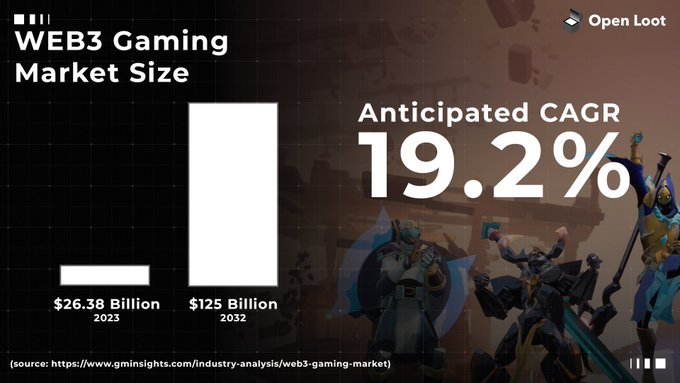Open Loot: Reshaping the Infrastructure of the Web3 Gaming Economy
Open Loot (OL) is a Web3 platform focused on building a protocol layer for game economies. It aims to lower the blockchain integration threshold for game developers through embedded NFT management tools and a token incentive system. Its core innovations include: a player-friendly portal that supports fiat purchases of NFTs, an asset trading system with fees as low as 1.5%, and a unique zero-team token allocation model (no pre-allocation for team or investors). As of June 2025, the platform has integrated 11 games, but due to the industry-wide shutdown wave, the number of new games per quarter has dropped by 60% year-over-year.

This Token Insights article delves into Open Loot’s zero-team token allocation mechanism and dual-track economic system, examining how it copes with the current Web3 game shutdown trend and its strategic transformation.
Tokenomics: A Community-Driven Allocation Experiment
OL tokens have a hard cap total supply of 5 billion, adopting an incentivized decentralized distribution strategy:
-
70% entirely owned by the community: 50% for player achievement rewards (released through tasks/events), 20% for marketing and airdrops;
-
30% as ecosystem reserve: used for liquidity incentives and partner expansion;
-
Zero pre-allocation to team and investors: completely avoids centralized sell-off risk (rare in the industry).
Token utility focuses on in-game circulation: players can earn OL through achievements, use it to buy NFT items (e.g., rare characters in Brawlers), participate in governance staking (e.g., to adjust platform fee rates), or exchange for real-world value. Currently, only 7.54% (377 million tokens) are in circulation, but the fully diluted valuation (FDV) is $319 million—13 times the circulating market cap. If ecosystem growth falls short, the high FDV may cause long-term depreciation pressure.
Investors can track token inflation risk using the JuCoin monitoring tool.
Open Loot’s Technical Architecture: Dual-Track Engine to Lower Barriers
Optimized Player Experience
-
Wallet abstraction login: supports email registration, auto-generates non-custodial wallet, eliminates mnemonic burden;
-
Fiat payment channels: NFTs purchasable directly via credit cards, auto-converted to on-chain assets (developers subsidize gas fees);
-
Cross-game asset interoperability: NFT items transferable across games on the platform (e.g., Brawlers, Crystopia).
Developer Tooling Innovations
-
One-click NFT issuance: studios can customize item attributes and rarity rules without writing smart contracts;
-
Compliance framework integration: built-in KYC/AML tools to meet EU MiCA regulations on game assets;
-
Real-time revenue sharing system: transaction fees are auto-distributed among developers, platform, and player reward pools.
Compared to competitors like Big Time (which requires holding tokens to pay gas), Open Loot significantly lowers entry barriers for new users. However, lack of multi-chain support (Ethereum-only) limits its appeal to developers in ecosystems like Solana.
Industry Crisis: The Web3 Game Shutdown Wave
A wave of mass game shutdowns in 2025 has directly impacted the Open Loot ecosystem:
-
Collapse of flagship projects: partner game Anterris shut down due to failed funding, instantly rendering player assets worthless;
-
Plummeting user retention: average industry retention rate fell to 30%, challenging OL’s incentive model;
-
Sharp decline in new games: only 3 new games integrated in Q1 2025 (a 60% drop YoY), stalling ecosystem growth.
The crisis exposes a core contradiction in Web3 games: tokenomics > gameplay. Most projects over-relied on token speculation; Blade of God X raised $6M but still collapsed due to shallow content.
Survival Strategy: Mobile and AI Transformation
Targeting the $160B Mobile Gaming Market
-
Mobile SDK development: simplifies Unity/Unreal engine integration, supports in-game NFT stores (testing in Q3 2025);
-
Low-spec optimization: smart contract efficiency improvements aim to cover mid-range Android users in Southeast Asia.
AIGC Redefining Game Asset Value
-
Dynamic NFT system: item attributes evolve based on player behavior (e.g., weapons level up based on kills), launching Q3 2025;
-
AI-generated quests: personalized storylines created based on player preferences, aiming to boost retention rate (target >35%).
Compliance Upgrades
-
Transparent loot boxes: publish probabilities and set spending caps (e.g., $100/day) to avoid gambling allegations;
-
Multi-chain expansion evaluation: SolanaVM integration plan to address high Ethereum gas fees.
Key Challenges and Success Metrics
Open Loot faces dual stress tests. Economic sustainability depends on player retention—if it fails to stay above the 30% industry baseline, reward pool token emissions will far exceed demand. Reserve fund burn rate must be tightly controlled; the current ecosystem fund (30% of total supply) must last until Q1 2026 to reach breakeven (target: $5M in platform fee revenue per quarter).
For developers, integration decisions hinge on monetization efficiency. Open Loot claims to cut game economy system development costs by 70%, but this requires validation from long-term revenue data of surviving games like Crystopia.





